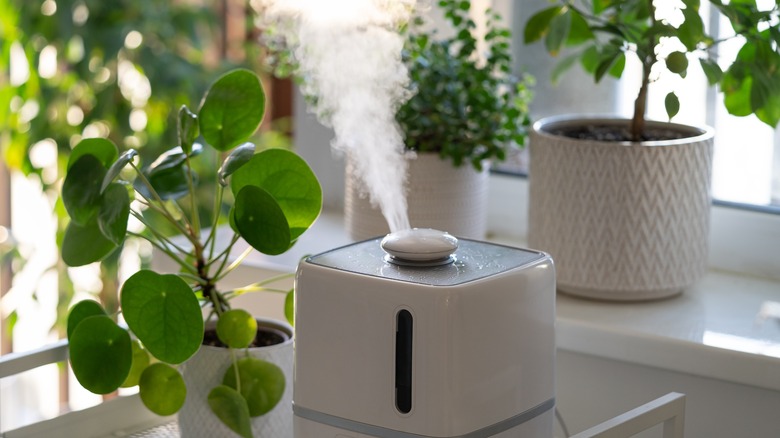If your house is hot, dry and filled with houseplants, it could harbor a spider mite infestation at any moment if it isn’t already. These itty-bitty pests can be hard to spot at first, so you may not see them until they’ve already done some damage to your greenery. The key to keeping spider mites off your plants is to make the space uninhabitable for them, so add a humidifier to the room to increase the humidity as much as possible. Spider mites can survive in humidity levels as high as 90%, but they certainly don’t thrive in that kind of environment, which will help reduce the population.
Spider mites do thrive when the humidity is below 50%, so placing a humidifier in your dry home can help increase the moisture enough that the spider mites won’t want to hang around for long. If you can’t keep your entire house humid, consider choosing one room to keep cool and moist to quarantine the plants that the spider mites decided to call “home.”
Use a humidifier to make spider mites move out

Spider mites are small but mighty — mighty annoying, that is. Spider mite damage will look like lots of little discolored dots on plant leaves, sometimes accompanied by webbing. They drink up the juices from your plant, which causes the discoloration. Spider mites prosper in dry environments, so adding a humidifier to your home can help decrease the population as the moisture around your plants increases.
The great thing about humidifiers is that they come in many shapes and sizes, allowing you to put them where you need them. You don’t need to humidify the entire room; keeping your plants close to a humidifier in the corner might be enough. Be sure to measure the humidity level with a digital hygrometer you can keep near your plants. Or, you can pick a room for quarantining infested plants to kill the population. Keep the room’s air moist with the help of a humidifier or two, and cool it with ceiling fans and floor fans. The reduced temperature with elevated humidity is the perfect recipe for spider mite mortality.
Humidifiers work well with other solutions
A humidifier by itself might be all you need to kiss those spider mites goodbye, but you can increase their effectiveness when you combine them with other methods. Increased humidity needs to stick around to be effective. According to Michigan State University, rainfall and irrigation increased the humidity enough to reduce spider mite populations, but it stopped being effective as soon as the moisture dried up on the leaves.
The soil is a great place to start when you try to raise your humidity. Though spider mites live on leaves, the females spend winter hiding in the soil. If your home is dry in the winter, your houseplants could be harboring females that will be responsible for a future infestation. You can also cover your plants with a cloche to keep humidity around specific plants, or you can set your plants on humidity trays.
Both of these methods are a bit debated among houseplant enthusiasts, however. Cloches can allow plant diseases to spread easily, while humidity trays offer very little improvement if your room is already pretty humid, and they can be a breeding ground for mold and other pests. But these methods — which some people like to use — might be worth trying out if you find yourself surrounded by tiny bugs in a dry home.